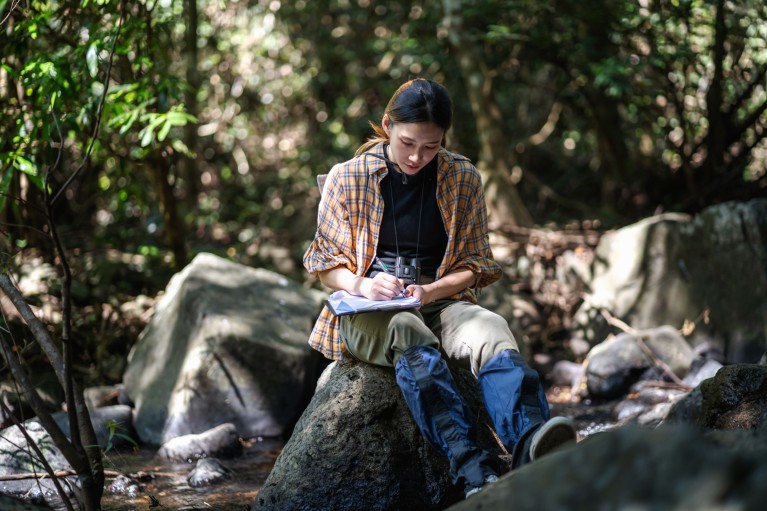You have full access to this article via your institution.

Despite progress in promoting gender equity in many fields of research, including ecology, disparities remain.
Credit: Getty
In March last year,
Nature
published a preliminary analysis of the number of men and women submitting manuscripts to the journal over a five-month period. The results, as we wrote in an Editorial at the time, made for sobering reading (see
Nature
627
, 7–8; 2024
). Among corresponding authors — who take responsibility for a manuscript as it goes through the publication process — just 17% of those who disclosed their gender identified as women. We pledged to reflect on this and other findings, while continuing to gather data. We also committed to increasing efforts to diversify the pool of corresponding authors and reviewers; on the latter,
we reported some initial results two weeks ago
.

Closing the Gender Gap: Peer Review at Nature Portfolio
Data analysts at Springer Nature,
Nature
’s publisher, have continued to track the gender of corresponding authors for
Nature
and a wider group of Nature Portfolio journals, and they report their latest findings this week (see
go.nature.com/3sm3d42
). In all, the team analysed 215,000 manuscripts submitted between January 2023 and July 2024. The analysis includes data from various stages of a manuscript’s publication journey — at submission, during peer review and when a paper is accepted for publication.
For
Nature
, it turns out that women make up around 16% of corresponding authors who submit manuscripts — a percentage that is slightly lower than our preliminary result and unchanged from 2018. Women comprise some 18% of corresponding authors who submit papers to
Nature Communications
and the Nature-branded research journals. For Communications journals (this series does not include
Nature Communications
), it is 22%.
The data show that the more-selective journals in the Nature Portfolio are also those with lower shares of submissions from corresponding authors who are women. However, there are notable variations between journals, depending on the discipline. For example, for psychology and life-science journals, women comprise, respectively, 33% and 23% of corresponding authors submitting manuscripts describing original research (not including review papers). By contrast, for computer science, this proportion is 13% and for chemistry and physics, it is barely above 10%. The comparatively high rates of women in health and life sciences and low rates in physical sciences and engineering are also reflected in data from other publishers, such as Elsevier (see
go.nature.com/4kfev9e
), and correspond to different levels of women’s representation in these fields.

Nature project to encourage early-career researchers in peer review is working
Studies point to several reasons why fewer women than men are submitting their work. For example, more-experienced colleagues might be discouraging them from doing so (
C. Ni
et al.
Preprint at bioRxiv 2023
). Evidence also suggests that women’s contributions to research are often undervalued, or devalued, compared with those of men, leading to disparities in authorship recognition (
C. Ni
et al.
Sci. Adv.
8
, eabe4639; 2021
).
As editors and as publishers, we are on a path to changing that, through targeted editorial policies as well as outreach. Editors of commissioned content across the Nature Portfolio are actively soliciting submissions from women. This is having a positive impact: review articles had notably higher shares of corresponding authors who are women than did original-research manuscripts, our analysis showed.
Similarly, we are widening the pool of peer reviewers through an initiative that encourages more-experienced researchers to act as mentors for their early-career colleagues, which is increasing the share of women participating in peer review. We are also noticing that papers with women as corresponding authors have a slightly higher rate of being accepted for publication when reviewed by a mixed-gender panel rather than by one comprising only men. Notably, the analysis did not find evidence of a negative bias towards women in editorial and peer-review processes.
Caveats and context
It is important to mention that no gender data are available for one-fifth of the papers submitted during the period covered by the analysis. This is because most of these articles were submitted by research administrators, who were not asked to disclose their gender. Furthermore, for the remaining manuscripts, around 10% of the corresponding authors preferred not to disclose their gender.
All things considered, the gender distribution of corresponding authors is an imperfect measure, because it does not necessarily represent a paper’s complete author list. Improving the diversity of all manuscript authors, ultimately, has to be the goal. But it is not one that we as editors, or indeed publishers, can achieve on our own. It needs a concerted effort from everyone in the research ecosystem: universities, businesses, governments and non-governmental organizations. We all need to acknowledge that it is our collective responsibility to act. That means that we must recognize, firstly, the scale of the problem (it is not small). And, secondly, that this is a systemic problem, and that solving it requires a plan of action involving all stakeholders in the research ecosystem.
At
Nature
, we will continue to report on our publishing practices, which will enable us to compare findings from one year to the next. Women make up around 34% of corresponding authors globally, according to 2024 data from the European Commission (see
go.nature.com/43cazw2
). Journals should be doing a better job of reflecting the contributions that women make to research and scholarly knowledge worldwide.


